|
 |
|
The early 20th century was a time of change. The town
became more prosperous because of the many successful
industries that started in the area and provided
employment for a large number of local people. The
increase in prosperity could be seen in the town centre
where a large number of shops and businesses provided a
wide range of products and services. Public transport
was better than ever thanks to frequent tram and train
services and locals could relax or take a boat ride in
the newly opened Victoria Park. |
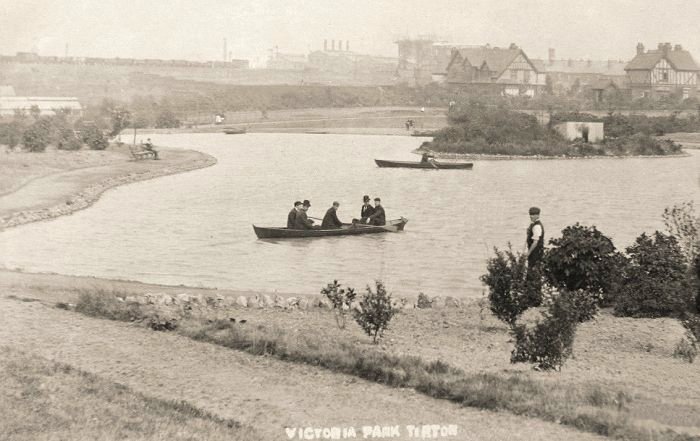
Victoria Park was opened
by the Earl of Dartmouth on Monday 29th July,
1901. Large numbers of people lined the streets
to view the procession of dignitaries and local
organisations, who took part in the opening
ceremony. |
| |
|
Read
about the formation of the Midland Electric
Corporation for
Power Distribution and Ocker Hill Power
Station |
 |
| |
|
| Councillor W. W. Doughty opened Tipton's
Central Library in Victoria Road on Wednesday
30th May, 1906 and on 12th August 1907 Joseph
Powell opened Toll End Library. Both libraries
were paid for by the philanthropist Andrew
Carnegie. In 1909 Queen Victoria's
granddaughter, Princess Marie Louise of
Schleswig-Holstein, came to Tipton to open a
nurses' home in Lower Church Lane. |
|
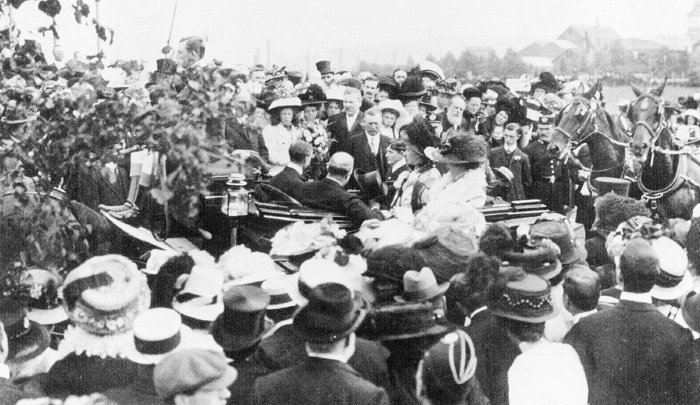
Princess Marie Louise of
Schleswig-Holstein at Tipton in 1909. From an
old postcard. |
|
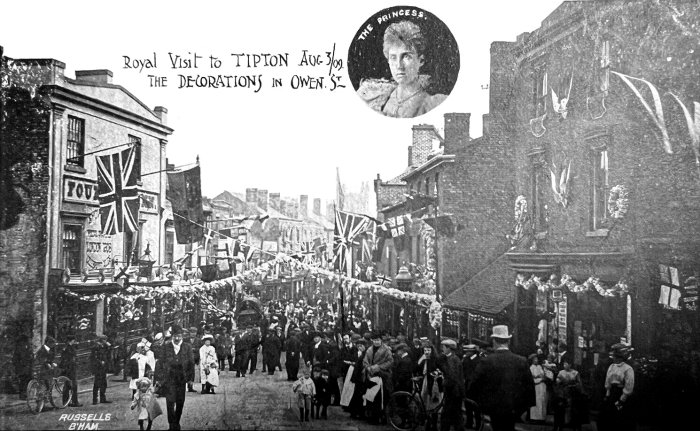
Princess Marie Louise of
Schleswig-Holstein's visit, commemorated on
an old postcard. |
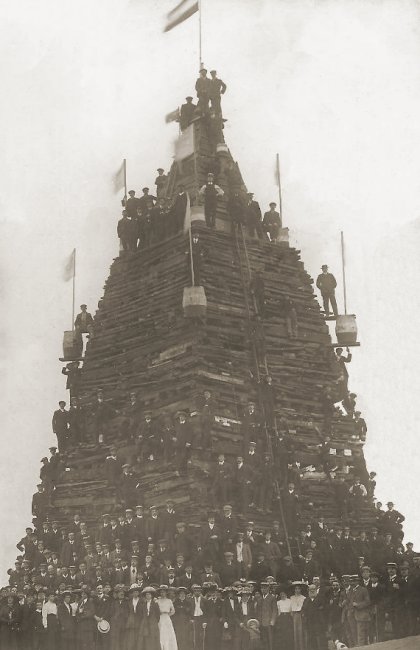 |
The Coronation of George V
and Queen Mary took place at
Westminster Abbey, on 22nd June 1911.
This
was celebrated at Ocker Hill, where a huge
bonfire was lit to mark the occasion.
The
bonfire was 69
feet high and weighed around 226 tons.
From an old postcard. |
|
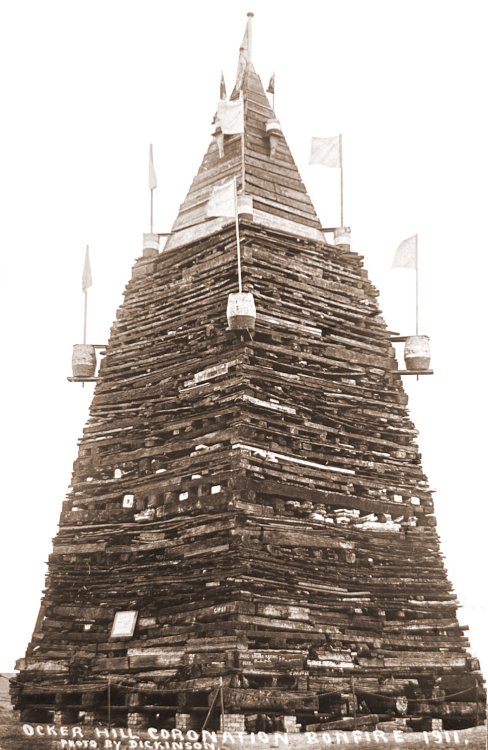
Another view of the
bonfire, also from an old postcard. |
|
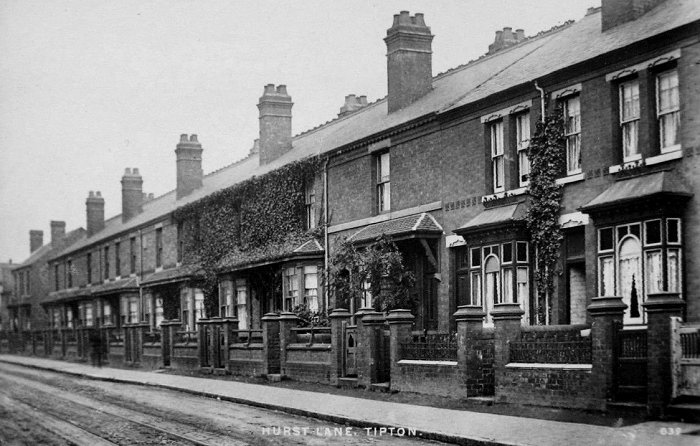
From an old postcard. |
| After 1910 cinemas became a popular form
of entertainment.
Tipton had a total of six,
some were successful, others were not. |
| |
|
|
Read about
Tipton's Cinemas |
 |
| |
|
View a 1912
Directory
of Tipton |
 |
| |
|
| View the 1912
report on health and hygiene |
 |
| |
|
| Owen Street was once a
vibrant shopping centre with
a wide variety of shops and
businesses, as can be seen
from the list below,
compiled from the 1912
Kelly's Directory. |
|
Street Number |
|
Business |
| |
|
Urban District
Council Offices |
|
1. |
|
Albion Hotel |
|
2. |
|
Walter Gordon's
coffee shop |
|
6. |
|
David Hughes,
picture frame maker |
|
7. |
|
Joseph
Whitworth, collector
of water rates for
South Staffordshire
Water Works |
|
9. |
|
George Wenyon,
architect |
|
11. |
|
Britannia public
house, Thomas Walton
landlord |
|
12. |
|
William Foster,
solicitor |
|
13. |
|
Tipton Herald.
Printers and
stationers |
|
14. |
|
James Halford,
shopkeeper |
|
15. |
|
Edward Darrall,
milk seller |
|
16. |
|
James Lister,
ironmonger |
|
17. |
|
Black Cock
public house |
|
19. |
|
Charles
Cotterell, baker |
|
20. |
|
James Stanton,
piano and organ
dealer |
|
21. |
|
Joseph Eades,
chemist |
|
22. |
|
Edward Starkey,
confectioner |
|
23. |
|
Alfred Morris,
dining rooms |
|
24. |
|
Edward Hipkins,
pork butcher |
|
25. |
|
Harry Johnson,
fruit shop |
|
26. |
|
Edgar Hawkins,
dining rooms |
|
27. |
|
Samuel Johnson,
confectioner |
|
28. |
|
Frank Jones,
draper |
|
29. |
|
Thomas Plimmer,
boot maker |
|
30. |
|
Tipton District
Permanent and
Benefit Building
Society |
|
31. |
|
Albert and
George Moyle,
grocers |
|
32. |
|
Mrs. Elizabeth
Thompson, butcher |
|
34. |
|
Samuel Fletcher,
boot and shoe maker |
|
36. |
|
Richard
Westwood, furniture
dealer |
|
38. |
|
The Grapes
public house, Robert
Fitzsimmons landlord |
|
39. |
|
Edward Hipkins,
pork butcher |
|
40. |
|
Thomas Price,
tobacconist |
|
41. |
|
Anthony McDadd,
fruiterer |
|
42. |
|
Hinton Atkins
and Son,
confectioner and
post office |
|
43. |
|
John Horton,
beer seller |
|
45. |
|
Albert
Hartshorne, boot
repairer |
|
47. |
|
Elton and Brown,
stationers |
|
48. |
|
Tipton Co-op,
grocers etc. |
|
49. |
|
Tipton Co-op,
grocers etc. |
|
50. |
|
Samuel Kirkham,
fish and chips |
|
51. |
|
The Fountain Inn |
|
53. |
|
Feltons Limited,
printers
|
|
55. |
|
Leader Press
Limited, newspaper
proprietors |
|
56. |
|
The Miner's Arms
public house, Henry
Ward landlord |
|
57. |
|
Mrs. Emma McDadd,
china and glass
dealer |
|
58. |
|
Henry Wood and Son,
grocers, 58 Owen
Street |
|
60. |
|
Thomas Richards,
tobacconist |
|
62. |
|
Alfred Turner,
hairdresser |
|
63. |
|
Joseph Ward,
draper |
|
64. |
|
William Merrick,
paint shop |
|
65. |
|
Joseph Edge,
hairdresser |
|
66. |
|
Thomas Yates,
watchmaker |
|
67. |
|
J. Whitehouse and
Sons, saddlers |
|
70. |
|
Henry Padbury,
grocer |
|
71. |
|
Philip Witton,
chemist |
|
72. |
|
Frederick
George, draper and
hosier |
|
73. |
|
John Green,
butcher |
|
76. |
|
Grafton Bullas,
tinplate worker |
|
81. |
|
Coombs Enoch.
Pork butcher |
|
82. |
|
Benjamin Cadman,
beef and pork
butcher |
|
83. |
|
Benjamin Cadman,
beef and pork
butcher |
| |
|
The Tivoli Music
Hall, Benjamin
Kennedy, proprietor |
|
85. |
|
John Millington,
confectioner |
|
87. |
|
Mrs. Jane Smith,
fancy repository |
| |
|
The Church of
St. Martin and St.
Paul |
| |
|
United Counties
Bank Limited, H. C.
Whitehouse, manager |
| |
|
Midland Electric
Corporation for
Power Distribution
Limited |
|
97. |
|
William and
Samuel Foster
Limited, corn
chandlers |
|
| Tipton's main shopping
area extended into Union
Street, as can be see from
the list of shops and
businesses in Union Street
in 1912: |
|
Street Number |
|
Business |
|
5. |
|
Bert Martin,
hairdresser |
|
11. |
|
Fred Hobson,
beer seller |
|
14. |
|
Mrs. Sarah
Buswell,
shopkeeper |
|
22. |
|
Samuel
Malugani,
shopkeeper |
|
23a. |
|
George
Freeman,
shopkeeper |
|
25. |
|
John
Hartland,
shopkeeper |
|
27. |
|
Alfred
Mander,
carpenter |
|
31. |
|
Arthur
Edwards, boot
repairer |
|
35. |
|
Miss. Annie
Hassell,
shopkeeper |
|
35a. |
|
Richard
Dewes, grocer |
|
35b. |
|
John Hurley,
baker |
|
36. |
|
Thomas
Taylor, beer
seller |
|
55. |
|
William
Mason,
shopkeeper |
|
59. |
|
Mrs. Eliza
Bodin, beer
seller |
|
60. |
|
David Smith,
shopkeeper |
|
68. |
|
William
Johnson, fish
and chips |
|
69. |
|
Mrs.
Beatrice
Hawthorne, baker |
|
75. |
|
Charles
Williams, beer
retailer |
|
77. |
|
Noah
Sheldon,
shopkeeper |
|
79. |
|
Samuel
Bishop, draper |
|
80. |
|
Miss.
Harriett
Clifton,
shopkeeper |
|
81. |
|
Harry
Williams,
butcher |
|
82. |
|
Mrs.
Elizabeth Yates,
shopkeeper |
|
85. |
|
Osborne
Lewis,
pawnbroker |
As well
as a large number of
public houses in 1912,
there were many fish and
chip shops,:
Joseph Artess, 233
Dudley Road, Tividale
John Baldwin, 244 Toll
End Road
Henry Dursley, 81 New
Road, Great Bridge
Mrs. Mary Garbett, 30
Spring Street, Ocker
Hill
George Hayes, 113 Dudley
Road, Tividale
John Hill, 101 Horseley
Heath
William Johnson, 68
Union Street
James Jones, 159
Horseley Heath
Samuel Kirkham, 50 Owen
Street
William Lambert, 196
Dudley Port
Harry Popple, 120 Bridge
Road
Mrs. Mary Preece, 252
Horseley Heath
Miss.Annie Sparkes, 51
Bell Street
Samuel Whitehouse, 132
Horseley Heath
Thomas Wordsworth, 41
Horseley Heath
|
|
|

An advert from
1909. |
| |
|
|
|
|
Read
about the terrible
Zeppelin raid in 1916 |
 |
|
Read about the terrible explosion in
Dudley Port in 1922 that killed 19
young girls |
 |
| |
|
|
|
|
|
A
New School
In 1926, building
work began on the Tipton Central Schools
in Alexandra Road, next to Tipton
Cemetery. The foundation stone was laid
by Councillor Thomas E. Salter, J.P. on
the 19th April, 1926. The building was
designed by Scott and Clark and built by
Mark Round & Sons. The official opening
by Councillor Simeon Webb, J.P.,
Chairman of the Tipton Education
Committee, took place on the 13th
October, 1927.
Pupils had to pass
an entrance examination to go to the
school, where they would start a four
year course, during which they could
choose to study in several areas:
academic, commercial, domestic, or
technical. They could also take the
Senior Oxford Examination if they wished
to go on to university or training
college.
There were separate
boys and girls schools under one roof,
which only came together on remembrance
day services in the school hall. The
original staff members were Mr. F. J.
Williams, headmaster, Miss B. B.
Walters, headmistress and Mr. J. Bailey,
Miss C. H. Bowyer, Miss W. G. Cansdale,
Mr. G. Dalton, Mrs. Gibbs, Mr. F. W.
Gilbert, Miss Greenwood, Mr. T. Lewis,
Miss M. Lloyd, Miss B. Robinson, Miss B.
B. Walters, Mr. J. Whitcroft and Mr. V.
C. Woodall.
One of the first
school plays, performed by the senior
boys in April 1929 was a version of
Sheridan's 'The Rivals', which was
viewed by an audience of 800 people.
During World War 2 the girls raised
£1,113. 15s. 0d. as part of War Weapons
Week in March 1941. In 1946 the school
became a Grammar School, then the County
Grammar School in 1948. The boys and
girls sections amalgamated in 1954 under
the headship of Mr. G. S. Smith.
In 1963 the school
building was extended with the addition
of new science laboratories, a library,
swimming baths, and a dining hall. A new
projects block was also added. In 1966
the school came under the control of
West Bromwich Education Committee as
part of the local government
re-organisation and in 1968 became
Alexandra High School. In September 1969
the school merged with Park Lane
Secondary School and became a
comprehensive school. Initially 'O'
Level and 'A' Level pupils were educated
at the Alexandra Road site and younger
pupils attended the Park Lane site.
The Alexandra Road
site was extended in about 1980 and the
Park Lane site was demolished in 1991. A
new sixth form centre was built in 1995
and improvements were made to the
buildings in 2011 and 2012. On the 1st
March, 2013 the school became the ACE
Academy, with over 1,400 pupils.
The
Housing Programme
In the 1920s,
Tipton Urban District Council started a
housing programme in which derelict land
would be reclaimed in readiness for the
building of council houses. Much of the
land was full of old coalmines, clay
pits and sand pits, all of which had to
be filled and made safe. There
were also old pit mounds, some of which were
over 50 feet high, that had to be
levelled. |
|

The Upper Church
Lane site in February 1938. |
|
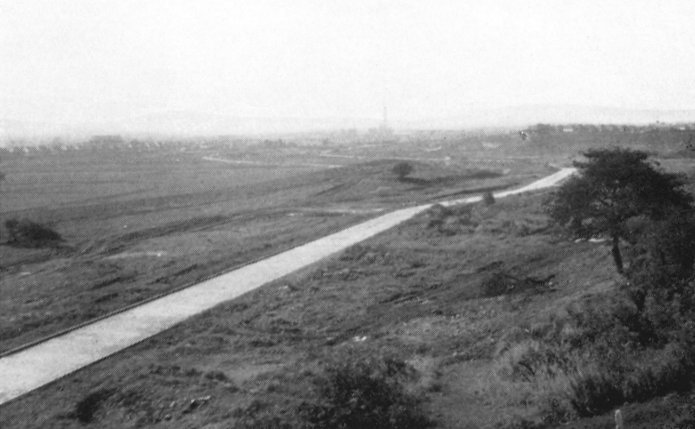
The Upper Church
Lane site in September 1938. |
|
The landscape of
Tipton rapidly began to change as the
work progressed. There were also around
2,300 houses that would be demolished as
part of the slum clearance programme.
The council's new housing estates included the
Shrubbery Estate at Tipton Green, the Tibbington Estate at Princes End, the
Moat Farm Estate at Ocker Hill and the
Cotterill's Farm Estate between Powis
Avenue and Bridge Road.
On the 21st December, 1936 the 2,000th
council house was officially opened on
the Tibbington Estate by Councillor A.
Jones. 3,186 council houses
had been built by 1938 and land had been
prepared for another 1,400.
Around 1,800 slum properties had been
demolished and something like 650 houses
had been built by private building
companies. |
|
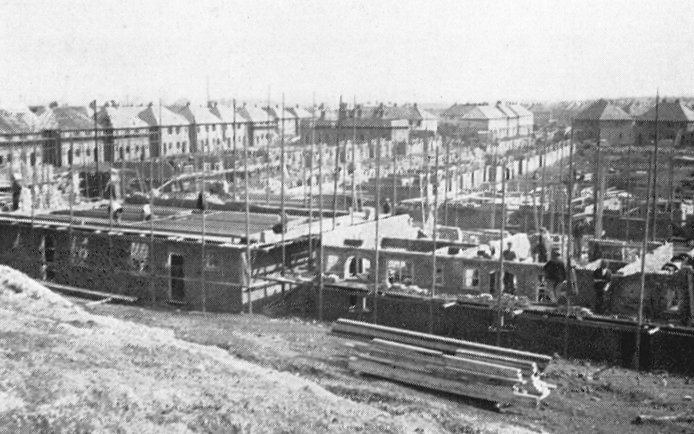
Gospel Oak Estate. |
|
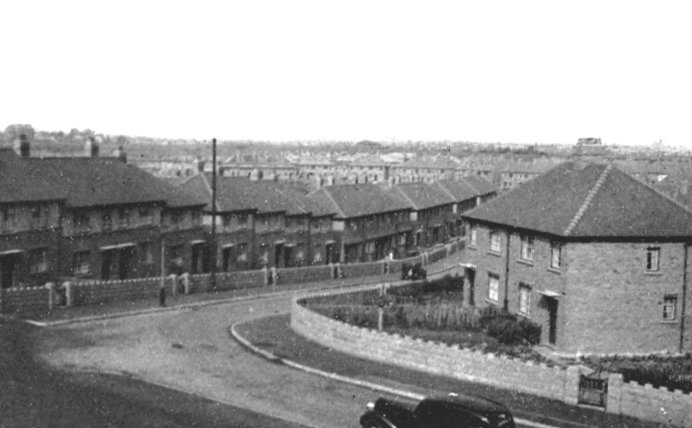
Moat Farm Estate. |
|
Tipton Council's last major
housing development, built in
the early 1960s, was the Glebefields
Estate, off Glebefields Road. The last
major private housing development was
the Foxyards Estate, on the southern
side of Sedgley Road West. It was built
in the mid 1960s.
The Public Baths in
Queens Road, designed by H. N. Woodard,
were officially opened on 25th January,
1933 by Councillor J. R. Baker. The main
pool was equipped with a filtration
plant and a chlorination plant so that
the water was continuously purified.
There were also 29 slipper baths and 3
foam baths. In the winter, the main pool
was covered with a maple floor,
so that dances and other functions could
be held. It could seat over 1,000
people.
The baths closed in the
summer of 2002 because of a lack of
council funding, but reopened within two
years after a successful campaign by
local people. It finally closed in 2011
and was relocated to the new leisure
centre in Alexandra Road. The old public
baths building went on sale in 2012 and
has since been demolished. |
|
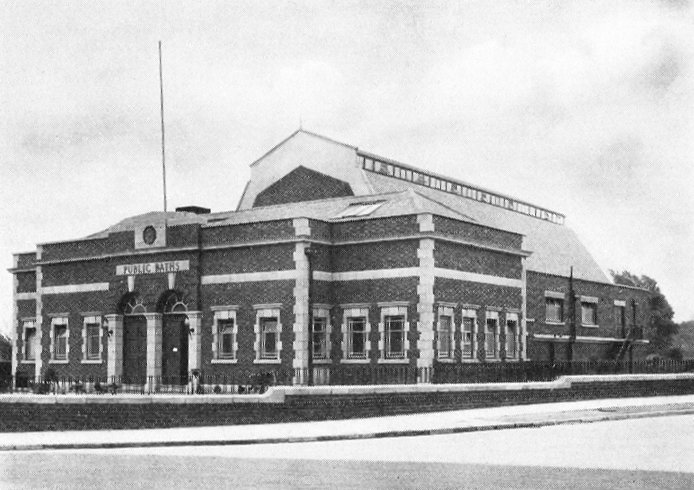
The public baths
in Queens Road. |
|
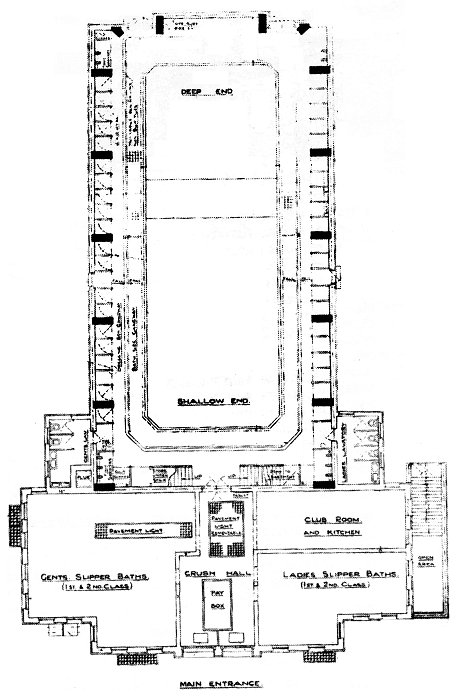
A plan of the
baths. |
|
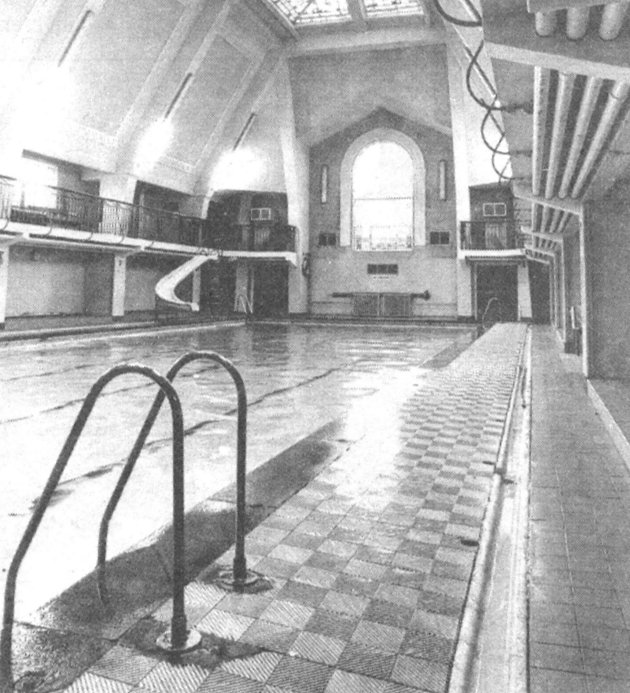
The swimming
pool. |
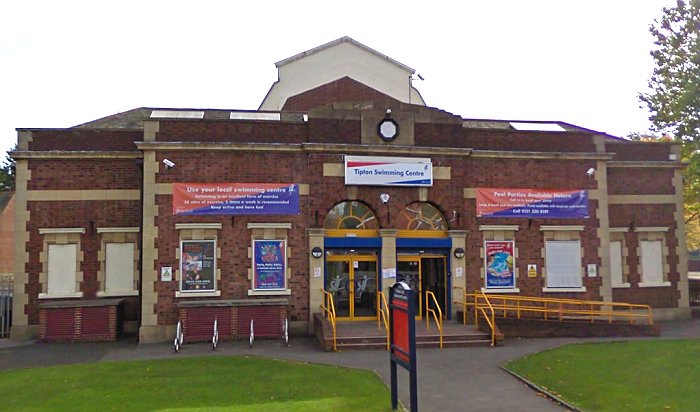
The baths in 2009.
|

Tipton's own
newspaper, The Tipton Herald, was
based in Owen Street and was
published for many years. |
|
Improvements and changes in the late
1930s
In
1935 Tipton acquired another public
park, Jubilee Park, originally called Ocker Hill Park.
It was officially opened on the 13th
April, 1935 by Councillor A. P. Welch,
J.P., Chairman of Tipton Urban District
Council and was built as part
of an unemployment relief scheme.
|
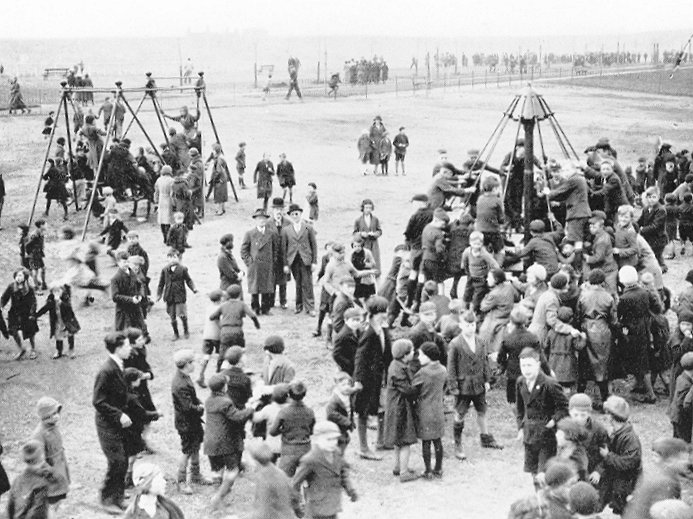
The
children's playground in
Jubilee Park. |
|
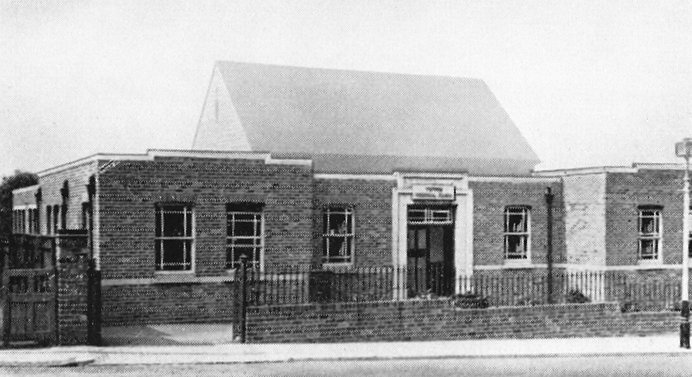
The
Central Clinic in Horseley
Road, which was officially
opened on the 30th July,
1936 by Councillor W. E.
Hampton. |
In 1936 the council moved into the
new Municipal Buildings in Sedgley Road
West. Two years later the town became
the Municipal Borough of Tipton after
the granting of a Royal Charter.
|

When
the town became a Municipal
Borough, a copy of this
sheet was given to every
school child in the borough.
Courtesy of Betty Johnson. |
Council Officials in
1936: |
|
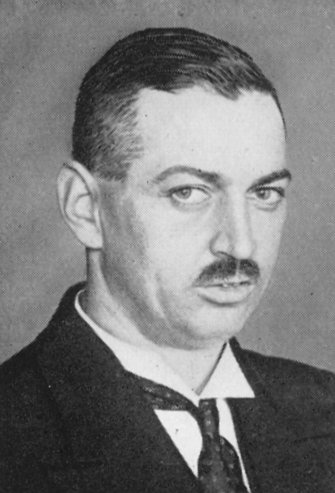
K. W. Madin.
Solicitor and Clerk. |
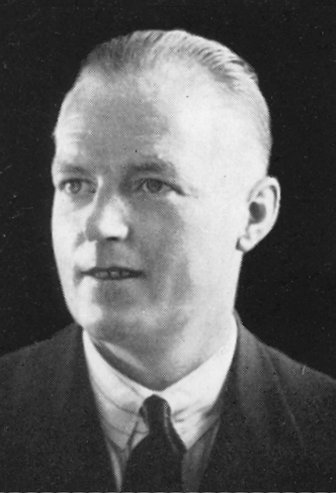
V. B. Tranter.
Assistant Clerk. |
|

H. N. Woodard.
Engineer and Surveyor. |
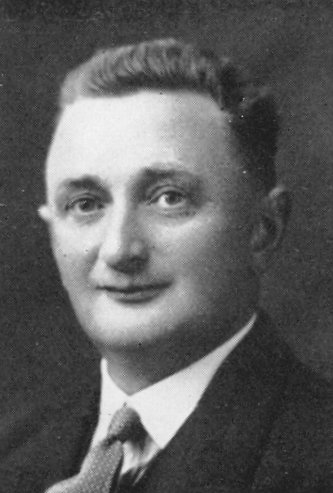
R. Pilling.
Treasurer. |
|
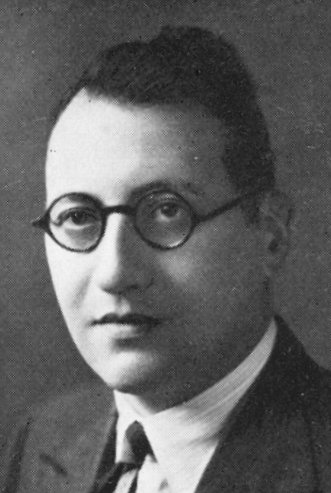
W. Williams. Gas
Engineer and Manager. |
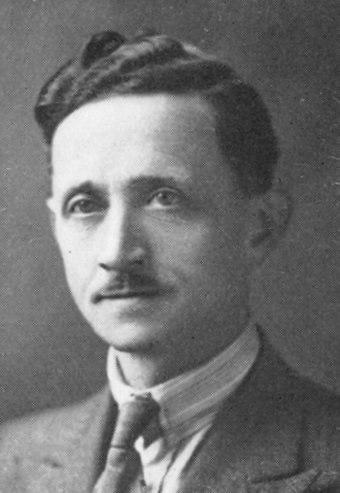
A Hastilow.
Director of Education. |
|
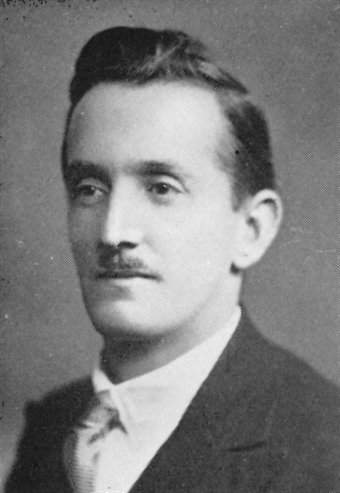
G. H. Acton.
Senior Sanitary Inspector. |
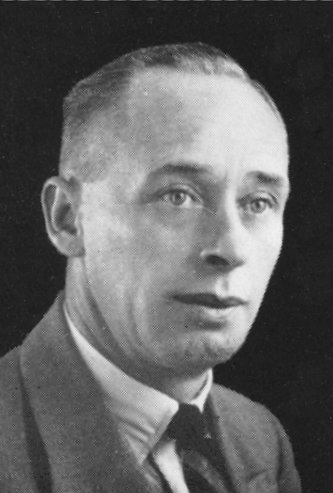
H. Scriven.
Housing Manager. |
|
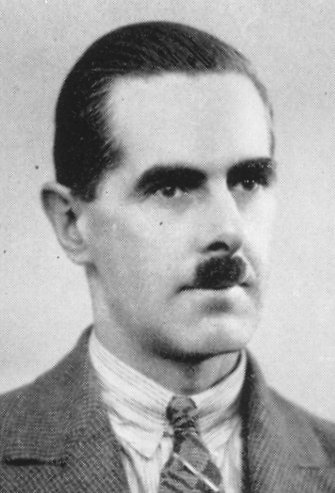
C. R. Gallie.
Housing Director. |
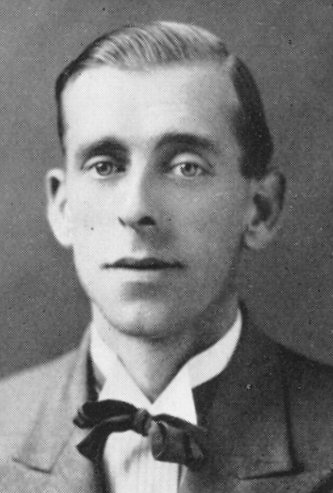
A. W. Taylor.
Librarian. |
|
The
Second World War
During the Second
World War, there were several air raids
in the locality, carried out by the
German Luftwaffe, which resulted in a
number of injuries and fatalities. On
the 19th November, 1940, a bomb was
dropped in Bloomfield Road. Three people
were killed and several buildings were
destroyed, including the Star Hotel
public house. One of the fatalities was
the son of the licensee. The pub was
rebuilt after the war, but closed, and
was demolished in 1996.
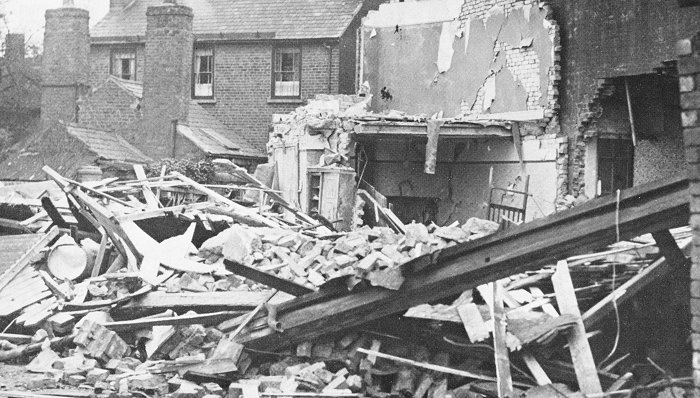
The aftermath of
the bombing in Bloomfield Road.
On the 21st
December, 1940, anti-aircraft guns were
in operation on the hills at Rowley
Regis. A shell from one of the guns fell
into the chimney of the Boat Inn, in Dudley
Road East, Tividale, fatally injuring 12
people. At the time, a wedding reception
was being held in the pub. The shell
exploded next to a cast-iron stove and
filled the room with the contents of the
fire and flying shards of
sharp, hot, metal.
The married
couple were Sid Jones and Lily Pottinger.
The bride was instantly killed and the
groom lost both legs. Six people died at
the scene, and six died in hospital. One
of them was a 20 year-old man who was
in a neighbouring house that was struck
by debris. He died in hospital on the
following day. Twelve people were
seriously injured. The pub was rebuilt
after the war, but has now disappeared.
It was demolished in 2004.
On the 17th
May, 1941, during an air raid at Great
Bridge, six people were killed and the
Tipton Tavern public house in New Road
and New Road Methodist Church
were destroyed. Several nearby houses
were also damaged. The landlord of the Tipton
Tavern, Roger Preece, was trapped in the
rubble, but luckily survived with minor
injuries. After the war, a
temporary wooden building was erected on
the site, until the pub could be
rebuilt. In 1996 it became the
Hallbridge Arms and then the Pearl Girl.
It closed in 2016 and is now a
children’s day nursery.
During the war,
Tipton was defended by the Forty First
Staffordshire (Tipton) Battalion of the
South Staffordshire Home Guard, which
was formed in May 1940 and operated
until December 1944. The commanding
officer was Lieutenant Colonel G. G.
Heathcock who had previously been in the
Royal Engineers. They were based at the
Municipal Buildings in Sedgley Road
West.
The Post War Years
| |
|
|
An article about some of
Tipton's last remaining slum
properties |
 |
| |
|
| Tipton gained
another area of parkland in June 1953
with the opening of Coronation Gardens
in High Street. The gardens were built
on derelict land that used to be
occupied by Townshead’s Warehouse, where
sacks of flour were stored after being transported along the canal from the
company’s mill at Worcester.
The canal
moorings beside the gardens are very
popular and since 2008 have been used
for part of the annual Tipton Canal and
Community Festival.
Also in High
Street, on the opposite side of the
traffic island to the gardens, is
Tipton's first multi-storey block of
flats called 'Coronation House'. The
building was officially opened by
Alderman A. E. Bolton in 1959. |
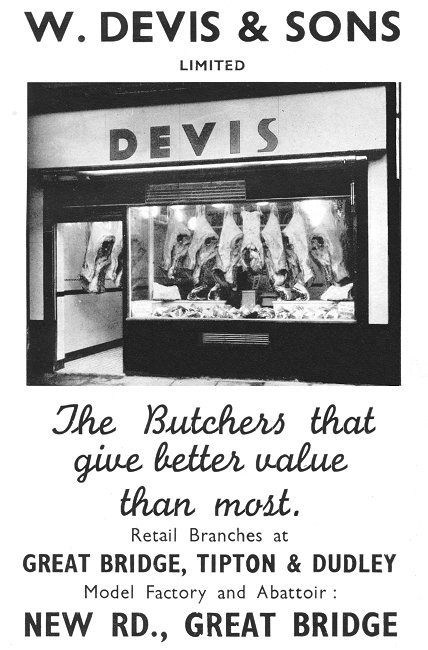
An
advert from 1947. |
|
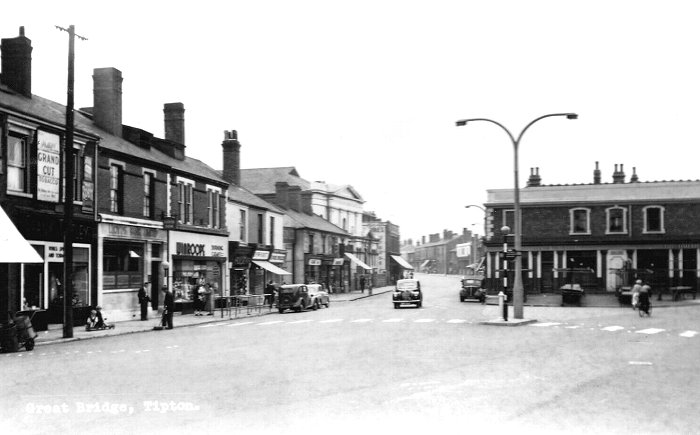
From an old postcard. |
|
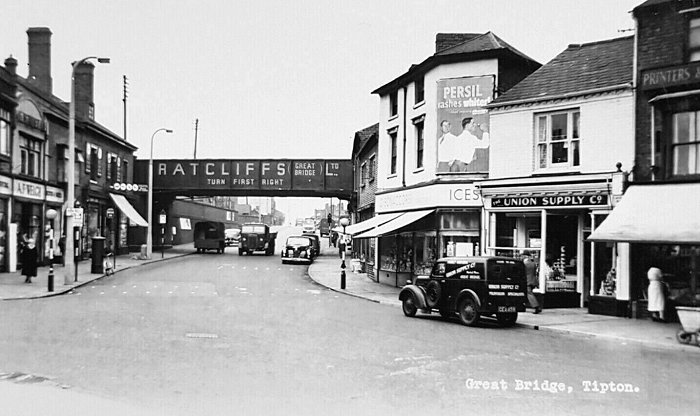
From an old postcard. |
|
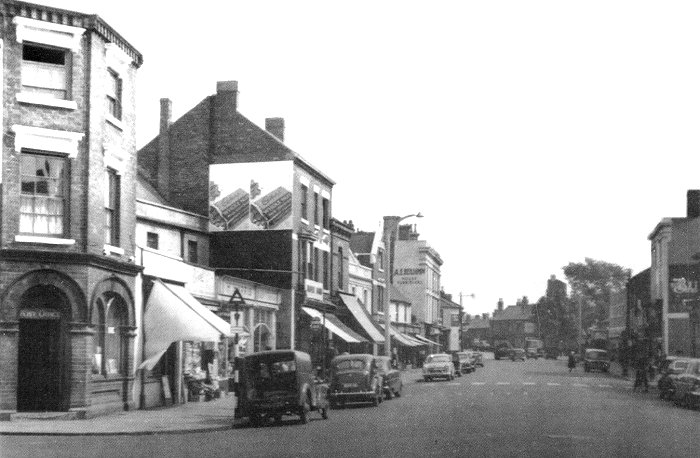
Another view of Great
Bridge from an old
postcard. |

A boat moored
alongside Coronation Gardens.
|
|
|
View the
Tipton
listing from
a 1961-62 Trades Directory |
 |
| |
|
The
Borough of Sandwell
In 1966 an
important event happened, as a result of
the Local Government Reform Act. Tipton
lost its Borough status and became part
of West Bromwich County Borough, along
with Wednesbury. To further complicate
matters, part of the old Tipton Borough
that was next to Coseley became part of
Dudley, including the former Municipal
Buildings and most of the Foxyards housing
estate. Most of Tividale became part of
Warley, and Tipton acquired a small
section of Coseley.
In 1974, West
Bromwich County Borough and Warley
County Borough merged to form the
Metropolitan Borough of Sandwell, within
the newly created West Midlands County
Council.
There were many
other changes in the 1970s. Tipton had
become one of the most industrialised
towns in the Black Country, but by the
late 1970s the factories were closing
and so large areas of industrial
dereliction were commonplace. Most of
the ex-industrial sites have now been
redeveloped and are occupied by housing
estates. The area has now become a
commuter town where many of the
inhabitants work in other local towns
and cities.
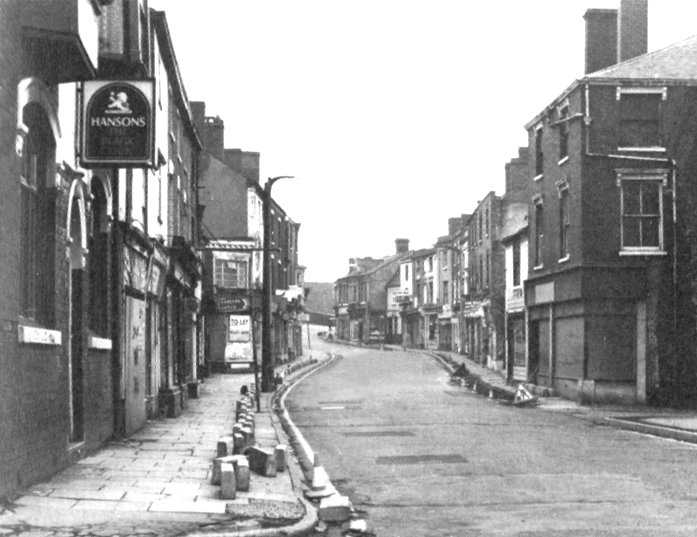
Owen Street before
redevelopment.
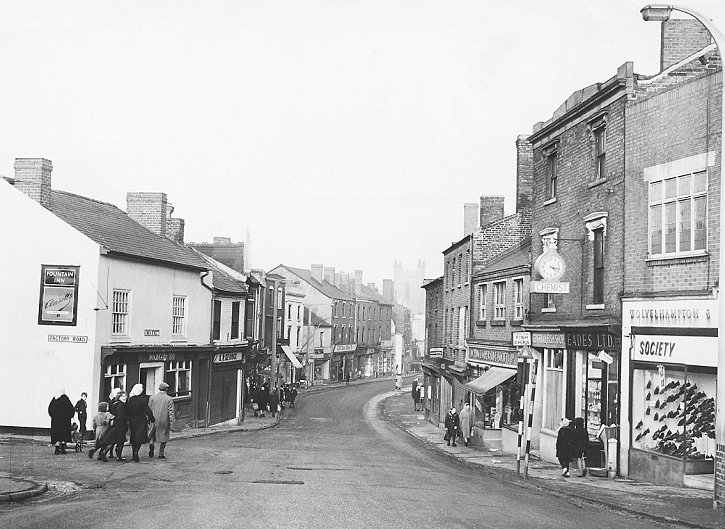
Another view of Owen Street before
redevelopment.

Owen Street.
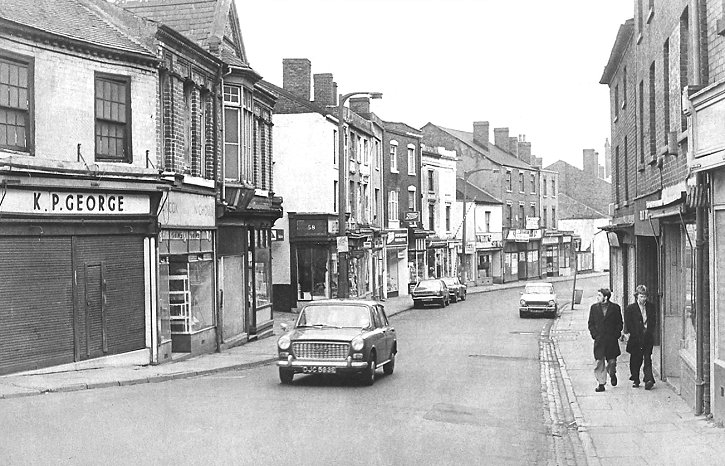
Owen Street.
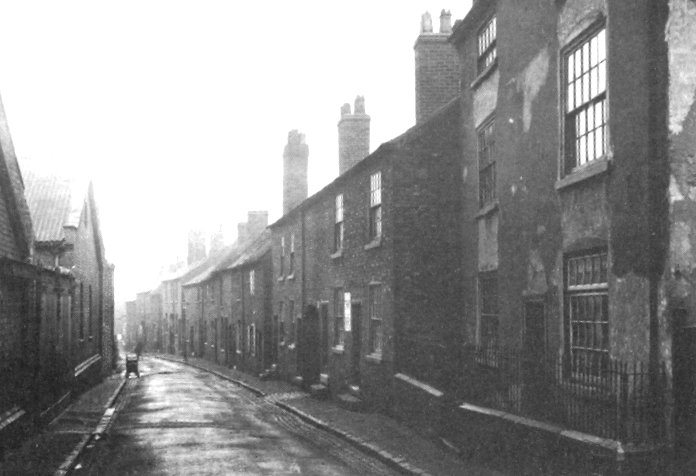
Old Cross Street
before redevelopment.
In 1971, Tipton’s
new fire station in Alexandra Road
opened and before the decade was out,
Owen Street, which was once full of
shops and businesses, had been
redeveloped. In the late 1970s and early
1980s, many of the old shops were
replaced with council houses and flats.
A small number of new shops were built,
along with a bank, a supermarket, and a
car park. In 2000, the pedestrian
shopping area between Union Street and
Owen Street called Unity Walk opened. It
includes 28 retail units, Tipton
Library and accommodation for businesses.
In 1982, the last
surviving canal stable block, next to
the old main line canal at Factory
Junction was saved from dereliction by
the council and converted into a
community outdoor activity centre.

The old stable
block.
In the 1990s,
Tipton was visited by two members of the
royal family and a deputy prime
minister. On the 24th June, 1994, the
first visit of a reigning monarch to the
town took place when the Queen visited
the headquarters of the Tipton Challenge
Partnership in High Street, as part of a
visit to the Black Country.
The Tipton
Challenge Partnership was established by
the government in March 1993 as part of
a regeneration programme. Within the
first five years of its existence, the
Partnership claimed to have brought £173
million of investment into the town and
helped to develop new housing,
workspaces, infrastructure and social
support programmes. The Queen was
received by Colin Cooke, Chairman of the
Tipton Challenge Partnership Board.
Whilst there she unveiled a plaque to
mark her visit.
On the 12th July, 1999, the Princess
Royal visited Tipton to open the Neptune
Health Centre in Sedgley Road West and
on the 12th June, 1998, the Tipton
Sports Academy in Wednesbury Oak Road
was opened by the Deputy Prime Minister,
John Prescott. |
| |
|
| 1994
and 1997 Tipton Carnival Programmes |
 |
| |
|
|

Pleasure boats on
the canal. |
| Modern Tipton is a very different place
from its industrial heyday. It has developed
into a pleasant residential town with a wide
variety of housing, local shops, and
plenty good shopping nearby in Dudley,
Wednesbury and Oldbury. There is an
excellent library with a local history
section, lovely parks, canals to be enjoyed, excellent pubs and
restaurants, a good railway station and good
bus services. There are also plenty of
schools and jobs to be had in the industrial
estates. Hopefully, Tipton will continue to
be a good place to live for generations to
come. |
| |
|
Read
about the commemoration of
the building of the Aaron Manby paddle
steamer at Horseley Works
in 1822. |
 |
| |
|
|
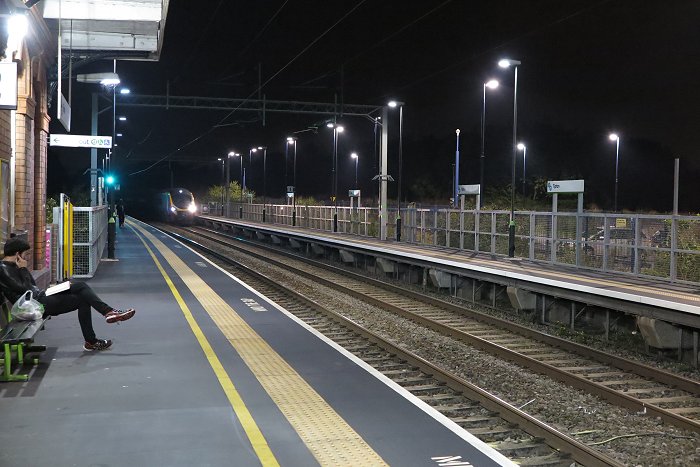
A train arrives at the
railway station. |
|
 |
 |
 |
|
Return to
Public Houses |
Return to
the
beginning |
Proceed to
References |
|